Marlow, Buckinghamshire
| Marlow | |
|---|---|
 Overlooking the River Thames and Marlow | |
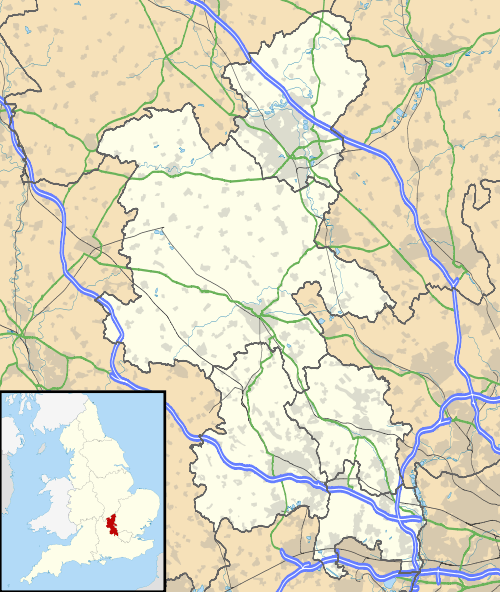 Marlow Marlow shown within Buckinghamshire | |
| Population |
14,004 (2011 Census)[1] 14,325 (2011 Census)[2] |
| OS grid reference | SU855865 |
| Civil parish |
|
| District | |
| Shire county | |
| Region | |
| Country | England |
| Sovereign state | United Kingdom |
| Post town | MARLOW |
| Postcode district | SL7 |
| Dialling code | 01628 |
| Police | Thames Valley |
| Fire | Buckinghamshire |
| Ambulance | South Central |
| EU Parliament | South East England |
| UK Parliament | |
Marlow (/ˈmɑːrloʊ/; historically Great Marlow or Chipping Marlow) is a town and civil parish within Wycombe district in south Buckinghamshire, England. It is located on the River Thames, 4 miles (6 km) south-southwest of High Wycombe, 5 miles (8 km) west-northwest of Maidenhead and 33 miles (53 km) west of central London.
Name
The name is recorded in 1015 as Mere lafan, meaning "Land left after the draining of a pond" in Old English.[3]
From Norman times the manor, parish, and later borough were formally known as Great Marlow, distinguishing them from Little Marlow. The ancient parish was large, including rural areas north and west of the town. In 1896 the civil parish of Great Marlow, created in the 19th century from the ancient parish, was divided into Great Marlow Urban District (the town) and Great Marlow civil parish (the rural areas). In 1897 the urban district was renamed Marlow Urban District,[4] and the town has been known simply as Marlow.
History
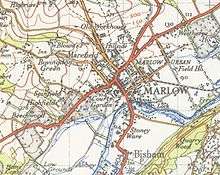
Marlow is recorded in the Domesday Book as Merlaue.[5]
Magna Britannia includes the following entry for Marlow: "The manor of Marlow, which had belonged to the Earls of Mercia, was given by William the Conqueror, to his Queen Matilda. Henry the First, bestowed it on his natural son, Robert de Melhent, afterwards Earl of Gloucester, from whom it passed, with that title, to the Clares and Despencers, and from the latter, by female heirs, to the Beauchamps and Nevilles, Earls of Warwick. It continued in the crown from the time of Richard III's marriage with Anne Neville, until Queen Mary granted it to William Lord Paget, in whose family it continued more than a century; after which, it passed, by purchase, to Sir Humphrey Winch, in 1670; to Lord Falkland in 1686; to Sir James Etheridge in 1690; to Sir John Guise in 1718; and to Sir William Clayton in 1736. It is now the property of Sir William Clayton bart. a descendant of the last purchaser".[6]
Marlow owed its importance to its location on the River Thames, where the road from Reading to High Wycombe crosses the river. It had its own market by 1227 (hence the name Chipping Marlow), although the market lapsed before 1600. From 1301 to 1307 the town had its own Member of Parliament, and it returned two members from 1624 to 1867.[4]
Geography
Marlow is adjoined by Marlow Bottom, a mile to the north. Little Marlow is nearby to the east along the A4155 Little Marlow Road and Bourne End is further along the same road. To the south across the Thames are Bisham (home of Bisham Abbey) and Cookham Dean, both in Berkshire,
Landmarks
There has been a bridge over the Thames at Marlow since the reign of King Edward III The current bridge is a suspension bridge, designed by William Tierney Clark in 1832, and was a prototype for the much larger Széchenyi Chain Bridge across the River Danube in Budapest.[7]
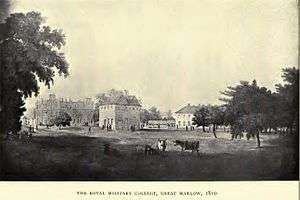
The Junior Wing of the Royal Military College, later moved to Sandhurst on the borders of Berkshire and Surrey, was once based in West Street, Marlow, at Remnantz, a large house built in the early 18th century which served as the Junior Department of the College from 1801 until 1812.[8] The weather vane on the building features a man firing a cannon and may date from that period. The building is now owned by the Bosley family.
The Hand & Flowers, the first gastropub to hold two Michelin stars, is located on West Street.[9] Like many local pubs, it serves the award-winning beers brewed locally in Marlow Bottom by the Rebellion Beer Company.
Marlow is the location of Marlow Lock, originating from the 14th century.
Twinning
Marlow is twinned with
Transport
The A4155 road runs through Marlow town centre, with the A404 lying one mile to the east, the M40 motorway further to the north, and the M4 motorway to the south.
Marlow is served by a railway station which is the terminus of a single-track branch line from Maidenhead. The train service is known as the Marlow Donkey, which was the nickname given to the steam locomotives that once operated on the line. There is also a pub with the same name, located close to the railway station.
Bus services are provided by Arriva and Carousel Buses to neighbouring towns including High Wycombe, Henley-on-Thames and Reading.
Education
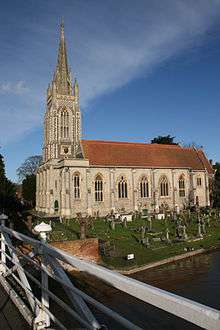
Education is provided by several schools, including:
- Great Marlow School (11–18)
- Sir William Borlase's Grammar School (11–18)
- Burford School (4–11)
- Danesfield School (4–11)
- Foxes Piece School (4–11)
- Holy Trinity Church of England School (7–11)
- Marlow Church of England Infant School (4–7)
- Spinfield School (4–11)
- St Peter's Catholic Primary School (4–11)
Sport
Marlow Rowing Club, founded in 1871, is one of Britain's premier rowing clubs and has produced many Olympic oarsmen including Sir Steve Redgrave. The club is based by Marlow Bridge and exercises above and below the lock. The Olympic lightweight men's double-sculls gold medallist at Beijing 2008, Zac Purchase, is a former member of Marlow Rowing Club.
Marlow F.C. is the oldest football club in the town, currently playing in Tier 8 Southern Football League Division One Central. It finished 4th of 22 in the 2016/17 season. Another local football club, Marlow United F.C., plays in Tier 11 Thames Valley Premier League Premier Division and finished 2nd of 14 in the 2016/17 season.
Marlow Rugby Club plays at Riverwoods Drive. It was founded in 1947 and runs a range of senior, youth and mini-rugby teams. The England Rugby team had its training base at Marlow RFC until the late 1990s, when it moved to nearby Bisham Abbey.
There are two cricket clubs, Marlow Park CC, and Marlow Cricket Club which was founded in 1829 and is now part of Marlow Sports Club. Marlow Cricket Club has three Saturday teams and plays in the Thames Valley League. The Sports Club caters to field hockey, tennis, running, cycling, junior football, netball and softball.
Regatta
There are two regattas associated with Marlow; the Marlow Town Regatta and Marlow International Regatta. Earliest records indicate a regatta took place annually on the River Thames in Marlow from 1855. The latter transferred to the purpose built Dorney Lake, owned by Eton College, in 2003. Marlow still hosts its Original River Regatta which takes place annually in June.
Marlow FM 97.5
Marlow FM[13] is a local community radio station that was launched on FM on 11 May 2011. It broadcasts to Marlow and the surrounding areas on 97.5FM, and also streams over the internet. The station provides travel and news updates for the local area.
Notable people
Notable current or former residents in approximate birth order.
- Local tradition has it that Jane Seymour lived at Seymour Court, about a mile north of Marlow, but this has not been confirmed.[14] Court Garden (before the house was built) was reputedly where Henry VIII courted her. A conference room at the Court Garden Leisure Complex is named after her.
- Dr William Battie, an eminent 18th-century physician specialising in mental illness, built and lived in Court Garden House from 1758 until his death in 1776. Local lore has it that he forgot to include a staircase to the first floor, so it had to be added later.[15] In 1789 his daughter sold the house to Richard Davenport, High Sheriff of Buckinghamshire, who lived there for 10 years,[16] during which, Court Garden was described in Boydells History of the River Thames (1793), as "a fine Georgian house standing on a gentle eminence, a lawn of some extent descending gradually from it to the river." In 1926 the estate was saved for the people of Marlow, largely due to the efforts of local resident and Crimean War veteran General George Higginson, after whom Higginson Park is named.[17]
- Percy Bysshe Shelley and Mary Shelley moved into a house in West Street in 1816. He composed The Revolt of Islam there in 1817, while Mary worked on Frankenstein. Thomas Love Peacock, who had suggested Shelley move to the town, wrote his novel Nightmare Abbey (1818) at a nearby house.[18]
- Jerome K. Jerome wrote part of Three Men in a Boat at a local pub, the Two Brewers.[19]
- T. S. Eliot lived in West Street during the First World War.[20]
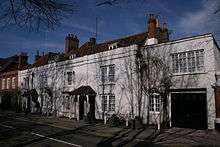
- Marlow Bottom has become the home of quintuple Olympic gold medallist rower Steve Redgrave, Britain's only athlete to have won gold medals at five consecutive Olympics. Higginson Park features a bronze statue of Sir Steven looking across the river towards the location of the finishing line of the Marlow Town Regatta. He is also commemorated in Redgrave Place.
- The pop singer Robbie Williams bought a house on the river in Bisham in 2015.[21]
- The Michelin star chef Heston Blumenthal, owner of The Fat Duck in Bray, Berkshire (voted Best Restaurant in the World in 2005) lived in Marlow until c. 2017.
- Actress Anna Acton was born in Marlow.
- Television and radio presenter Paul Ross, brother of Jonathan Ross, also lived in Marlow, having moved there after filming Celebrity Fit Club at nearby Bisham Abbey. He moved out of Marlow in 2013.[22]
- Japanese Formula One racing driver Takuma Sato was a Marlow resident, as was Bruno Senna, who lived in the same house.
- Pakistani cricketer and International Cricket Council (ICC) match Referee Wasim Raja lived in Marlow and worked as a cricket coach in a local school.
- Musician Jim Capaldi lived in Marlow for many years with his wife and two daughters until his death in 2005.
- England scrum-half and World Cup-winner Matt Dawson spent his childhood in Marlow and went to a local primary school.[23]
- England goalkeeper David Seaman owned a property in Marlow until 2012.[24]
- Peter Firth, Sir Harry Pearce in the BBC MI5 drama Spooks, is a Marlow resident.
- Andrew Strauss, former England cricket captain, moved to Little Marlow with his family in 2010.
- The television presenter and naturalist Steve Backshall lives in Marlow.
Cultural references
Marlow was the subject of a poem by Joseph Ashby-Sterry, A Marlow Madrigal.[25]
Gallery
- Court Garden House, former home of Dr William Battie
 Rowers on the Thames at Marlow
Rowers on the Thames at Marlow Marlow High Street
Marlow High Street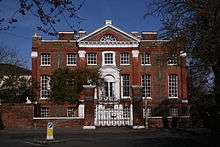 Marlow Place
Marlow Place The Two Brewers, where Jerome K Jerome wrote much of Three Men in a Boat
The Two Brewers, where Jerome K Jerome wrote much of Three Men in a Boat The Compleat Angler, Marlow
The Compleat Angler, Marlow Looking towards Marlow from Marlow Lock
Looking towards Marlow from Marlow Lock Marlow Lock
Marlow Lock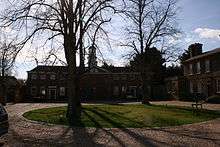 Former Royal Military College, Marlow 1802-1812
Former Royal Military College, Marlow 1802-1812 Former Wethered Brewery, Marlow
Former Wethered Brewery, Marlow
References
- ↑ neighbourhood Statistics 2001 Census
- ↑ "Civil Parish population 2011". Neighbourhood Statistics. Office for National Statistics. Retrieved 24 November 2016.
- ↑ Watts, Victor, ed. (2010), "Marlow", The Cambridge Dictionary of English Place-Names, Cambridge University Press
- 1 2 William Page (editor) (1925). "Parishes: Great Marlow". A History of the County of Buckingham: Volume 3. Institute of Historical Research. Retrieved 14 July 2011.
- ↑ Mills, A D, Dictionary of English Place-Names, Oxford University Press (1991)
- ↑ Great Marlow as described in "Magna Britannia", 1806
- ↑ Christopher Winn: I Never Knew That about the Thames (London: Ebury Press, 2010), p. 108.
- ↑ Town Tour Marlow Society
- ↑ Duncan, Fiona (16 November 2010). "The Hand and Flowers, Marlow: hotel review". The Daily Telegraph. Retrieved 6 February 2012.
- ↑ Marlow Town Twinning Association
- ↑ "British towns twinned with French towns". Archant Community Media Ltd. Retrieved 2013-07-11.
- ↑ The Marlovian, September 2009
- ↑ Marlow FM
- ↑ British History Online
- ↑ The Marlow Society
- ↑ UK & Ireland Genealogy/ Archived 21 February 2009 at the Wayback Machine.
- ↑ Wycombe District Council Archived 22 October 2007 at the Wayback Machine.
- ↑ Christopher Winn: I Never Knew That about the Thames (London: Ebury Press), p. 110.
- ↑ Christopher Winn: I Never Knew... p. 111.
- ↑ Christopher Winn: I Never Knew... p. 110.
- ↑ Davidson, Max (6 May 2016). "Revealed: the top 10 UK second home hotspots of the super-elite". The Daily Telegraph.
- ↑ LBC Radio Archived 20 July 2007 at the Wayback Machine.
- ↑ "Me and my school photo: Rugby star Matt Dawson". Daily Mail. 22 May 2009.
- ↑ Crick, Andy (11 March 2010). "Seaman's wife divorces him". The Sun. Retrieved 2012-02-19.
- ↑ Ashby-Sterry, Joseph. "A Marlow Madrigal". Bartleby.com. Retrieved 22 August 2016.
External links
| Wikimedia Commons has media related to Marlow, Buckinghamshire. |
